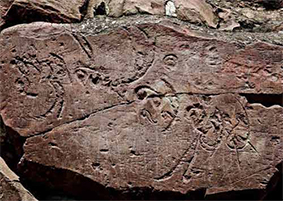Indian History
Gupta Period Temple Remains Found: UP
- 18 Sep 2021
- 6 min read
Why in News
Recently, the Archaeological Survey of India (ASI) discovered remains of an ancient temple dating back to the Gupta period (5th century) in Bilsarh village in Uttar Pradesh’s Etah district.
- The Bilsarh site was declared ‘protected’ in 1928 by the ASI.
Key Points
- About:
- Two pillars were excavated on which there is an inscription about Kumaragupta I, the powerful ruler of Gupta dynasty, in ‘sankh lipi’ (conch script or shell script) typical of the 5th century AD.
- The Guptas were the first to build structural temples, distinctly different from the ancient rock-cut temples.
- The inscription was deciphered as Mahendraditya which was the title of king Kumargupta I who had even conducted ashwamedh yagya during his rule.
- The statue of a horse having similar inscription is at the state museum in Lucknow.
- Ashvamedha Yagya is a horse sacrifice ritual followed by the Srauta tradition of Vedic religion.
- The discovery becomes significant since only two other structural temples from the Gupta age have been found so far — Dashavatara Temple (Deogarh) and Bhitargaon Temple (Kanpur Dehat).
- Two pillars were excavated on which there is an inscription about Kumaragupta I, the powerful ruler of Gupta dynasty, in ‘sankh lipi’ (conch script or shell script) typical of the 5th century AD.
- Shankhalipi Script:

- Also called “shell-script” is found in inscriptions across north-central India and dates to between the 4th and 8th centuries.
- Both Shankhalipi and Brahmi are stylised scripts used primarily for names and signatures.
- The inscriptions consist of a small number of characters, suggesting that the shell inscriptions are names or auspicious symbols or a combination of the two.
- It was discovered in 1836 on a brass trident in Uttarakhand’s Barahat by English scholar James Prinsep.
- Prominent sites with shell inscriptions: Mundeshwari Temple (Bihar), the Udayagiri Caves (Madhya Pradesh), Mansar (Maharashtra) and some of the cave sites of Gujarat and Maharashtra.
- These inscriptions are also reported in Indonesia’s Java and Borneo.
- Also called “shell-script” is found in inscriptions across north-central India and dates to between the 4th and 8th centuries.
- Kumaragupta-I:
- He was the Successor of Chandragupta-II and had a long reign from 414 to 455 A.D.
- He performed the Asvamedha Yajna which was confirmed by Asvamedha coins. The discovery of his 1395 coins confirms his extension towards the South.
- His period is also regarded as forming part of the Golden Age of the Guptas.
- Towards the middle of the fifth century A.D. The reign of the Kumaragupta-I was disturbed by the revolt of Pushyamitra tribe and the invasion of the Hunas.
- His greatest achievement was his repulsing the attack of the Pushyamitra.
- After the death of Kumaragupta-I Skandagupta succeeded in 455 A.D. and reigned from 455 to 467 A.D.
Gupta Empire
- About:
- The Gupta Empire stretched across northern, central and parts of southern India between 320 and 550 CE.
- The period is noted for its achievements in the arts, architecture, sciences, religion, and philosophy.
- Chandragupta I (320 – 335 CE) started a rapid expansion of the Gupta Empire and soon established himself as the first sovereign ruler of the empire.
- It marked the end of 500 hundred years of domination of the provincial powers and resulting disquiet that began with the fall of the Mauryas.
- It began a period of overall prosperity and growth that continued for the next two and half centuries which came to be known as a Golden Age in India's history.
- Governance:
- The efficiency of their martial system was well known. The large kingdom was divided into smaller pradesha (provinces).
- Trade:
- Gold and silver coins were issued in great numbers which is a general indicator of the health of the economy.
- Trade and commerce flourished both within the country and outside. Silk, cotton, spices, medicine, priceless gemstones, pearl, precious metal and steel were exported by sea.
- Religion:
- Literature:
- Poet and playwright Kalidasa created such epics as Abhijnanasakuntalam, Malavikagnimitram, Raghuvansha and Kumarsambhaba. Harishena composed Allahabad Prasasti, Sudraka wrote Mricchakatika, Vishakhadatta created Mudrarakshasa and Vishnusharma penned Panchatantra.
- Varahamihira wrote Brihatsamhita and also contributed to the fields of astronomy and astrology. Genius mathematician and astronomer Aryabhata wrote Surya Siddhanta which covered several aspects of geometry, trigonometry and cosmology. Shanku devoted himself to creating texts about Geography.
- Architecture:
- The finest examples of painting, sculpture and architecture of the period can be found in Ajanta, Ellora, Sarnath, Mathura, Anuradhapura and Sigiriya.





-min.jpg)